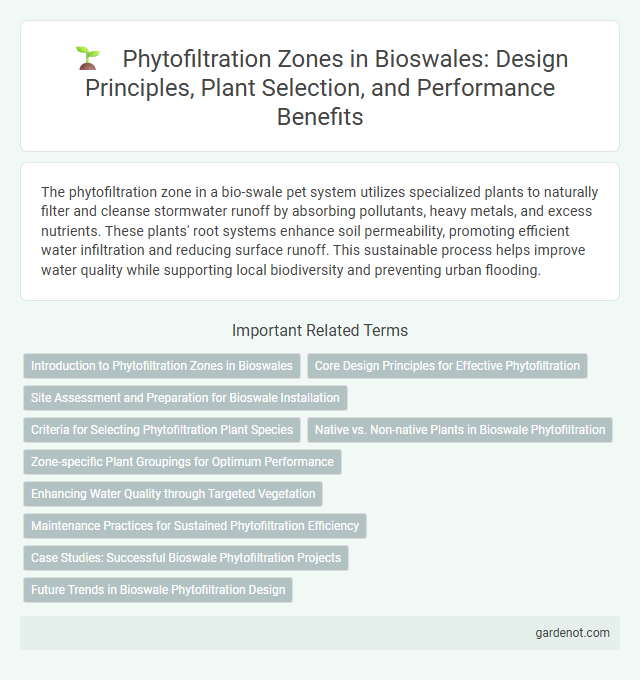The phytofiltration zone in a bio-swale pet system utilizes specialized plants to naturally filter and cleanse stormwater runoff by absorbing pollutants, heavy metals, and excess nutrients. These plants' root systems enhance soil permeability, promoting efficient water infiltration and reducing surface runoff. This sustainable process helps improve water quality while supporting local biodiversity and preventing urban flooding.
Introduction to Phytofiltration Zones in Bioswales
Phytofiltration zones in bioswales utilize specific plant species to remove contaminants from stormwater through natural filtration and absorption processes. These zones are strategically designed with vegetation that targets pollutants such as heavy metals, nutrients, and suspended solids, enhancing water quality before it reaches groundwater or nearby water bodies. Integrating native wetland plants like cattails, reeds, and sedges maximizes phytofiltration efficiency while supporting local ecosystems.
Core Design Principles for Effective Phytofiltration
The core design principles for effective phytofiltration in a bio-swale include optimizing plant selection based on root structure and pollutant uptake capacity to maximize contaminant removal. Incorporating diverse native vegetation enhances microbial activity and promotes nutrient cycling within the root zone, improving water quality. Proper soil composition and hydrologic control ensure sustained moisture levels critical for plant health and filtration efficiency.
Site Assessment and Preparation for Bioswale Installation
Site assessment for bioswale installation involves analyzing soil permeability, existing vegetation, and water flow patterns to ensure optimal phytoremediation efficiency in the phytofiltration zone. Preparation includes grading the land to promote proper drainage, removing impermeable layers, and amending soil with organic matter to support native plants known for pollutant uptake. Accurate site evaluation and tailored preparation enhance the bioswale's capacity to filter stormwater runoff and improve water quality through effective phytofiltration.
Criteria for Selecting Phytofiltration Plant Species
Selecting phytofiltration plant species for bio-swales requires prioritizing native plants with high pollutant uptake efficiency and tolerance to fluctuating water levels. Species should exhibit robust root structures to enhance sediment trapping and support microbial degradation processes. Optimal choices also consider growth rate, maintenance needs, and adaptability to local soil and climate conditions to ensure long-term bio-filtration performance.
Native vs. Non-native Plants in Bioswale Phytofiltration
Native plants in bioswale phytofiltration zones enhance pollutant removal by supporting local ecosystems and promoting soil health, leading to improved infiltration and nutrient uptake. Non-native plants may offer faster growth or unique filtration properties but risk disrupting local biodiversity and require more maintenance. Selecting native species like sedges, rushes, and willows optimizes long-term ecological balance and filtration efficiency in bio-swale systems.
Zone-specific Plant Groupings for Optimum Performance
The phytofiltration zone in a bio-swale utilizes strategically selected plant groupings to maximize contaminant removal and water infiltration. Species such as Carex spp., Juncus effusus, and Typha latifolia are preferred for their robust root systems and high pollutant uptake efficiency. These zone-specific plants enhance nutrient absorption, sediment capture, and microbial activity, optimizing the bio-swale's overall performance in stormwater management.
Enhancing Water Quality through Targeted Vegetation
Phytofiltration zones in bio-swales use targeted vegetation such as reeds, cattails, and sedges to enhance water quality by absorbing and filtering pollutants from runoff. These plants facilitate the removal of heavy metals, nutrients, and sediments through root absorption and microbial interactions within the rhizosphere. Implementing diverse native species in the phytofiltration zone optimizes pollutant uptake and supports sustainable stormwater management.
Maintenance Practices for Sustained Phytofiltration Efficiency
Regular inspection and removal of accumulated sediments in the phytofiltration zone prevent clogging and promote optimal water flow. Seasonal pruning and replanting of native vegetation maintain plant health and enhance pollutant uptake capacity. Application of nutrient management strategies and monitoring soil conditions support sustained phytofiltration efficiency and system longevity.
Case Studies: Successful Bioswale Phytofiltration Projects
Case studies of successful bioswale phytofiltration projects demonstrate the effectiveness of native wetland plants in removing heavy metals, nutrients, and suspended solids from stormwater runoff. For instance, the Portland Bioswale Initiative utilized a mix of Carex and Juncus species, resulting in a 40% reduction in nitrogen and phosphorus loads. Similarly, the Chicago Green Infrastructure Program reported a 35% decrease in total suspended solids after implementing phytofiltration zones with Typha latifolia and Scirpus validus, showcasing scalable urban water quality improvements.
Future Trends in Bioswale Phytofiltration Design
Emerging trends in bioswale phytofiltration design emphasize the integration of native plant species with high pollutant uptake capacities to enhance contaminant removal efficiency. Advances in sensor technology enable real-time monitoring of water quality, optimizing maintenance schedules and adaptive management. Innovative substrate materials with enhanced adsorption properties are being developed to improve nutrient and heavy metal filtration in future bioswale systems.
Phytofiltration zone Infographic

 gardenot.com
gardenot.com